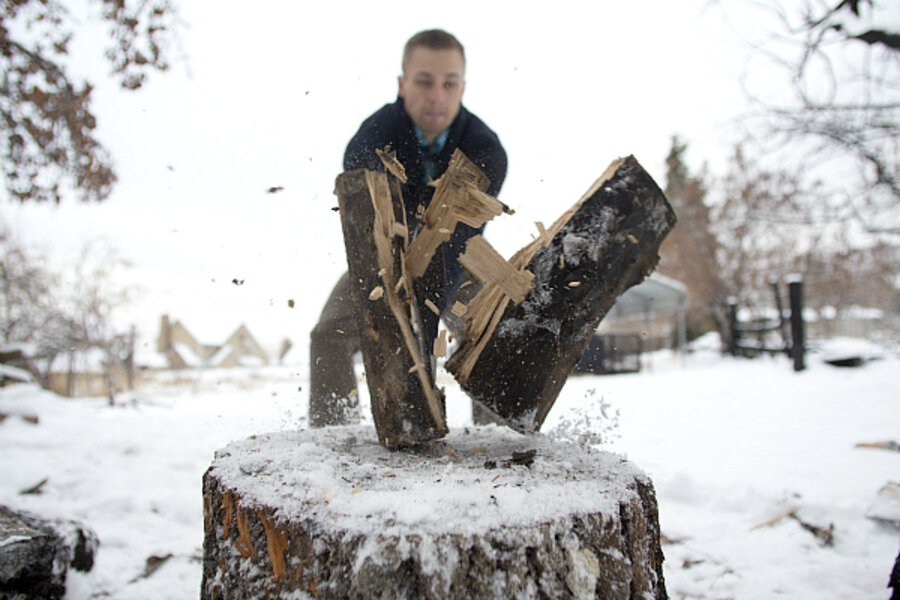Nonprofits' message: Keep firewood close to home
Loading...
| Weston, Conn.
What munches on wood in Pennsylvania should stay in Pennsylvania. Likewise what burrows in Oregon should stay in Oregon.
Transporting firewood across state lines can spread insects and diseases, thereby wiping out swaths of forests. Because this can cause considerable economic and environmental damage, The Nature Conservancy oversees a "Don’t Move Firewood" website. The site, which gives state-by-state information, encourages people to buy locally harvested wood.
“We absolutely see that the longer there is a presence of a "Don’t Move Firewood" campaign in a state the more the public becomes aware. States without ‘Don’t Move’ just don’t get it,” says Lee Greenwood, coalitions and network manager for The Nature Conservancy, a nonprofit group that works around the world to protect ecologically important land and water.
The "Don't Move" site grew from an effort called the Continental Dialogue on Non-Native Forest Insects and Diseases, a loose-knit group of organizations and individuals working to keep ecological invaders at bay.
While The Nature Conservancy owns the site, other nonprofit and government organizations are involved. They include the American Forest Foundation, the National Association of State Foresters, the Society of American Foresters, and the Pennsylvania Department of Agriculture.
Native trees can defend themselves against native insects and diseases. But trouble ensues when non-native insects and diseases show up, hitching a ride on firewood transported from elsewhere.
"That’s What Tree Said" and "Tree shirts" are available for purchase on the "Don't Move" site – a humorous way to raise awareness about this issue.
“If you lived in New England 100 years ago, you’d lie awake worrying about gypsy moths. Now South Carolina worries about them. Something like this spreads quickly,” Ms. Greenwood says.
The leaf-munching Asian longhorned beetle is one of biggest threats to New England’s maple trees, threatening the fall foliage season. Restaurants, hotels, farm stands, and maple syrup distributors count on the annual tourism: Leaf peepers account for nearly $300 million in annual revenue in Vermont alone, according to the state's tourism and marketing department.
In Oregon the more than 700 licensed Christmas tree growers produce about 8 million trees a year. This year slugs are hitching rides to Hawaii on these Christmas trees. As a result, nearly half of the trees shipped to Hawaii are in quarantine.
In Pennsylvania, environmental officials have thus far contained the Asian longhorned beetle. But many other fast-moving pathogens and insects lurk, says Sven-Erik Spichiger, manager for the Pennsylvania Department of Agriculture’s entomology program.
“Eighty percent of Pennsylvania’s forests are oak. If a fast-moving pathogen or insect threatened them, well, it really staggers the mind to think about it,” Mr. Spichiger says. Sap beetles, which carry oak wilt, are one such fast-moving threat.
That’s why signs on Pennsylvania state parks tell campers not to bring in their own firewood.
Some states, such as Connecticut, Vermont, and New Hampshire, simply advise against moving firewood while New York, Maine, and Massachusetts all prohibit importing wood from other states, or long-distance movement within their state. People are encouraged to check the "Don't Move" site to see the rules for their state.
How far is too far to move firewood? Generally 50 miles is too far, and 10 miles or less is best, according to “Don’t Move Firewood.” People are advised to check the website’s interactive state-by-state map.
In addition, “woody debris from storms is also a concern,” Spichiger says. It’s not a good idea to give away wood from fallen branches and trees, or leave it curbside for passersby. The final destination for the wood is unknown. However, it is okay to use such wood as mulch or for one’s own woodstove or fire pit.
“All it takes is one piece of wood,” Spichiger says, for a pest to infest a new area.
• Sign up to receive a weekly selection of practical and inspiring Change Agent articles by clicking here.







